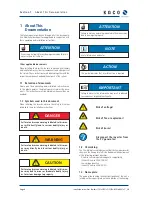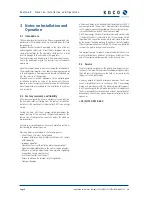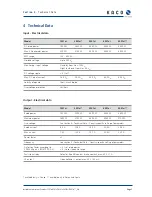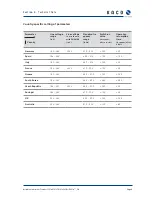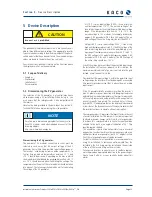
Page 14
Operating Instructions Powador 1501xi/2501xi*/3501xi/4501xi/5001xi**
S e c t i o n 6 ·
T r o u b l e s h o o t i n g
6 Troubleshooting
In line with our continuously expanding quality assurance system, we endeavour to eliminate all errors and faults. You have purchased
a product which left our factory in proper condition. Each individual unit has successfully passed an endurance test as well as extensive
tests for the purpose of assessing the operating behaviour and the protective equipment.
If your photovoltaic installation does not function properly despite these measures, we suggest the following troubleshooting proce-
dures:
The fi rst step is to check that the solar generator and grid connections are properly connected to the Powador. In doing so, observe all the
safety instructions specifi ed in this manual. Monitor the inverter closely and, where applicable, make a note of the displays and LEDs.
The following faults may occur and should be remedied as described.
Fault
Cause of fault
Troubleshooting/Explanation
Inverter displays an
impossible daily peak
value.
Faults in the line voltage.
Inverter continues to operate normally, without losses to the
yield, even when an erroneous daily peak value is displayed.
The value is reset overnight. To immediately reset the value,
the inverter must be switched off and switched on again by
disconnecting it from the grid.
Daily energy yields do
not correspond with the
yields on the grid opera-
tor’s grid feed meter.
Tolerances of the meas-
uring elements in the
inverter.
A measurement error occurs due to the measuring elements’
tolerances. The daily energy yield may deviate from the yield on
the grid feed meter by up to 15 %.
The line fuse trips.
The line fuse capacity is
–
too low.
Damage to the inverter’s
–
hardware.
In cases of high insolation, the inverter can - depending on the
solar generator - exceed its rated current for a short period. For
this reason, the capacity of the inverter’s pre-fuse should be
somewhat higher than the maximum grid feed current.
The line fuse immediately trips when the inverter switches to
grid feed mode (after the start-up period is complete). In such
a case, there is damage to the inverter’s hardware. Should this
be the case, the unit must be repaired by KACO new energy
GmbH.
The display is blank.
The unit is in night
–
shutdown mode.
There is no line voltage.
–
The solar generator volt-
–
age is lower than 125 V.
The inverter switches off overnight. If the display does not light
up during the daytime, check the grid feed meter to see if power
is still being supplied to the grid. If power is being supplied to the
grid, the display module is faulty. The inverter must be repaired
by KACO new energy GmbH. If power is not being supplied to
the grid, check to see if there is any line voltage and if the solar
generator voltage is greater than 125 V. If both are the case
and the display is still blank, the unit must be repaired by KACO
new energy GmbH.
The inverter does not
start up, LED (1) is off.
The unit is in night
–
shutdown mode.
There is no line voltage.
–
The solar generator volt-
–
age is lower than 125 V.
The inverter switches off overnight. The display and all three
LEDs are off. If the inverter does not start up during the daytime,
check to see if there is any line voltage and if the solar genera-
tor voltage is greater than 125 V. If both are the case and the
inverter still does not start up, the unit must be repaired by
KACO new energy GmbH.
The inverter is active
but does not feed into
the grid. Display shows:
Start at 125 V meas.
xxx V
Insuffi cient generator
voltage available. The
measured voltage is lower
than 125 V.
When there is insuffi cient solar insolation due to bad weather
conditions (after sunrise, at sunset), the generator voltage or the
generator power that comes from the roof may be too low to
be able to supply power to the grid. If the inverter has switched
off because the power is too low, it waits a country-specifi c time
period (see Installation Instructions, section 4, Technical Data)
before attempting to feed in once again.

















